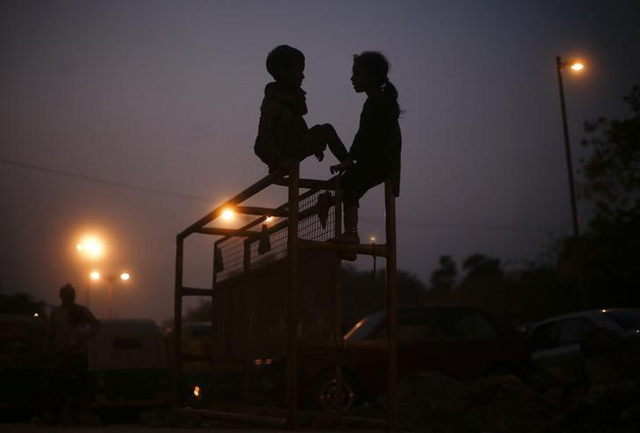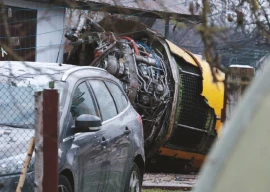
The skinny little boy, with big brown eyes and an infectious smile, had just returned from school and told his mother he wanted to play outside before lunch.
When she called for him 15 minutes later he was gone.
"It's been nine months since I saw him. He was still wearing his school uniform - a pink shirt and blue shorts. Someone must have taken him. He always played nearby," said Pinki Sharma, 35, Piyush's mother, by phone from Hatia in Jharkhand state.
India arrests heads of adoption centre over trafficking
"My husband has travelled to many places looking for him, but no one knows anything. But I will look for him until I die."
Piyush is one of about 250,000 children registered as missing on the government's Track Child portal between January 2012 to March 2017 - that's five children vanishing every hour.
But campaigners say these figures are just the tip of the iceberg, as many cases are not registered by parents or the police, and the children dismissed as runaways.
Most, however, are sold into slavery in a country where poverty prevails and child labour is normalised, despite being banned.
The Track Child data also shows nearly 73,000 children - 30 per cent - are still missing despite a raft of initiatives to better protect and find these children.
A lack of training of police, child welfare and protection officials, poor coordination between agencies in different states, coupled with massive public apathy is hampering the battle to locate India's 'lost generation', say campaigners.
Poverty-stricken, then enslaved
Missing children are so common in India that notices printed in classified sections of India's daily newspapers are buried alongside tender notices and job vacancies, with blurred black and white photos alongside a description and a contact number.
Pintu, 10, last seen at a Delhi railway station wearing a red sweater and black trousers. Shiwani, 16, who vanished outside her home in southern Delhi, dressed in blue jeans. Pooja, 13, in white shalwar kameez, last seen in a Delhi market.
Each notice ends in the same way: Sincere efforts have been made by local police to trace out this missing girl/boy, but no clue has come to light so far.
Campaigners say some of these children are abused runaways. Others are abducted. Some come from poor families duped by traffickers with the promise of a good job. Some are girls in love - lured by boyfriends who sell them into prostitution.
New software to help Indian police snare human traffickers
Rishi Kant from Shakti Vahini, a Delhi-based anti-trafficking charity, says up to 70 per cent of the missing children found are victims of trafficking and slavery.
"Most are trafficked by organised gangs who know the system. They know how to lure, transport and sell them on to employers," said Kant, who is involved in rescuing trafficking victims.
"As a result, they end up locked in brothels, wealthy homes and small workshops - making it hard to detect them or for them to escape."
India has one of largest populations of children in the world, with more than 40 per cent of its 1.2 billion people below the age of 18, according to its 2011 Census.
An economic boom of the last two decades has lifted millions out of poverty yet many children continue to be born into dire circumstances with India home to over 30 per cent of the world's 385 million most impoverished children, according to a 2016 World Bank and UNICEF report.
They make easy prey for traffickers, fed promises of a job and a better life but often ending up in forced labour.
While some children manage to escape or are rescued in police raids after tip-offs from activists or local residents, others are not so fortunate, trapped for years.
"The problem is that in many places police are not trained and not integrated into the existing mechanism to register and trace missing children," said P M Nair, chair professor and research coordinator on human trafficking at the Tata Institute of Social Sciences in Mumbai.
"They often do not see the link between missing children and trafficking and may dismiss the case as a runaway child, rather than register it as a crime and investigate it."
There is also little communication between police, government officials and activists - making it difficult for those where the child goes missing to coordinate with counterparts where the child may have been taken, he added.
Hidden in plain sight
Year-on-year figures are not available to determine whether the number of missing children is rising, but government crime data from 2015 shows an almost 60 per cent rise in reported kidnappings and abductions of children over five years.
The National Crime Records Bureau data also show related crimes such as trafficking and buying and selling of minors for the purpose of prostitution rising over the same period.
The country's first comprehensive anti-human trafficking legislation is being drafted, providing for a special investigative agency to coordinate between states.
Two official web portals have been set up to register missing children. The ‘Khoya Paya’, or ‘Lost and Found’, website is for public use, while Track Child allows police, government and charities to better coordinate.
Child Line, a 24-hour toll free helpline, has been running nationally for over a decade. Over nine million calls were received in 2015/16 with over 25,000 about missing children.
The government has also launched various public awareness campaigns on India's vast railway network - the main form of transport used by traffickers - while a periodic police drive "Operation Smile" screens children in shelter homes, train and bus stations, and on the streets to find the missing.
"There has definitely been a major push by police to find missing children in the last few years," said a police official from Delhi's crime branch, who did not want to be named.
"Initiatives like Operation Smile in various parts of country has helped us find hundreds of missing children."
But some missing children are in public view despite being enslaved, escalating the need for greater public awareness, say campaigners.
They loiter at traffic lights in cities, weaving between cars and knocking on windows to beg, or in make-shift roadside eateries washing dishes, or in fields of cotton, rice and maize, toiling in the heat and exposed to toxic pesticides.
Disturbing dilemma of child trafficking
In wealthy middle class homes, they clean and care for children sometimes older than themselves, and in brothels they wait with painted faces to be raped by stranger after stranger.
"Some of these children are in the open. Just a few weeks ago, for example, we managed to find a missing boy who was trafficked and forced to beg in Delhi," said Raju Nepali from Duars Expressmail, an anti-trafficking charity based in Jalpaiguri in northeastern India.
"No one - not the police or the public - even try to inquire about these children. They have become part of normality, maybe because they are poor. So we don't question who they are, why they are there and who they are with."

1721377568-0/BeFunky-collage-(18)1721377568-0-165x106.webp)















COMMENTS
Comments are moderated and generally will be posted if they are on-topic and not abusive.
For more information, please see our Comments FAQ